Hawks Vs Falcons: A Detailed Comparison of Raptors
Birds of prey have long captured our imagination with their aerial prowess and fierce hunting skills. Among these magnificent hunters, hawks and falcons are true avian athletes. With razor-sharp talons and keen eyesight, they command the skies and strike fear into the hearts of their prey.
But what is the difference between Hawks vs Flcons? While hawks and falcons may belong to the same group of raptors, they are far from identical. This detailed comparison delves into the distinct characteristics that set them apart.
We will shed light on their physical differences, hunting techniques, habitats, and much more. So buckle up and prepare to soar through the world of these captivating predators.
What Distinguishes Hawks from Falcons?
Below is a table illustrating their differences briefly:
| Hawks | Vs | Falcons |
| Broad, rounded wings and shorter tails | Shape | Sleek, pointed wings and longer tails |
| Varies greatly, typically medium to large (18 to 30 inches) | Size | Varies greatly, from small to medium-sized (8 to 26 inches) |
| Varied plumage, often with brown or gray tones | Coloration | Vibrant and contrasting plumage patterns |
| Perch-and-pounce, soaring, and ambush predators | Hunting Styles | Agile aerial hunters are known for high-speed pursuits |
| Small to medium-sized mammals, birds, reptiles | Prey | Birds, tiny to medium-sized species |
| Found worldwide, diverse habitats and climates | Regions | Found worldwide, diverse habitats and climates |
| Forests, grasslands, deserts, wetlands, urban areas | Types of Environments | Open spaces, grasslands, mountains, coastlines |
| Flap and glide, hovering capabilities | Flight Pattern | Swift and acrobatic flight, rapid wingbeats |
| Moderate to fast speeds | Hunting Speed | Exceptional speed, renowned as the fastest birds |
| Broad and rounded | Wing Shape | Long and pointed |
| Build nests on trees or cliffs | Nesting Habits | Often use scrape nests on ledges or structures |
| Various calls, including screeches and screams | Vocalizations | Distinctive vocalizations, such as “klee” or “kee” |
How Can You Identify a Hawk in the Wild?
Identifying a hawk in the wild might seem daunting, but here are the features you need to check for:
- Size and shape: Hawks are medium to large-sized birds of prey with a distinct shape. They have broad, rounded wings and a relatively short, fan-shaped tail. Unlike other raptors, like eagles or vultures, hawks generally have a more compact and stocky appearance.
- Head and beak: Pay attention to the hawk’s head. It typically appears larger in proportion to its body, and the beak is sharp and hooked at the tip. This hooked beak is a necessary adaptation for tearing into their prey.
- Coloration: Hawks come in various colors and patterns, but most have a mix of browns, grays, and whites. Look for dark markings on their wings and a lighter underside. Some hawks have striking red or orange eyes, while others may have yellow or pale-colored eyes.
- Flight pattern: Observe the hawk’s flight pattern. They are known for their graceful soaring and gliding abilities, using thermals to ride the air currents effortlessly. They flap their wings deliberately and steadily, and their flight is often characterized by a series of flaps followed by short glides.
- Perching behavior: Hawks often perch on high vantage points, such as treetops or utility poles, scanning the area for potential prey. This perching behavior gives them an excellent view of their surroundings.
Here is a YouTube video to further identification of hawks:
How Can You Identify a Falcon in the Wild?
To help you on your journey, here are some key features and behaviors to look out for when trying to identify a falcon:
- Shape and size: Falcons are characterized by their slim, streamlined bodies with long, pointed wings. Their wingspan typically ranges from 2 to 3 feet (60 to 90 cm), depending on the species. Compared to hawks, falcons appear more slender and agile in flight.
- Coloration: The coloration of falcons varies among species, but they commonly display a combination of dark and light feathers. Many falcons have a blue-gray or slate-colored back, while their undersides can range from pale to creamy white with dark barring or spots. Some species, such as the Peregrine Falcon, exhibit a distinctive black “mustache” mark on their face.
- Flight pattern: Falcons often exhibit rapid wingbeats, giving them a swift and dynamic appearance. Pay attention to their swift movements and impressive aerial maneuvers.
- Facial features: Look for their distinctively shaped heads, which often appear smaller than their bodies. Falcons have a sharply hooked beak that delivers precise and powerful strikes to their prey.
How do the Habitats of Hawks and Falcons Compare?
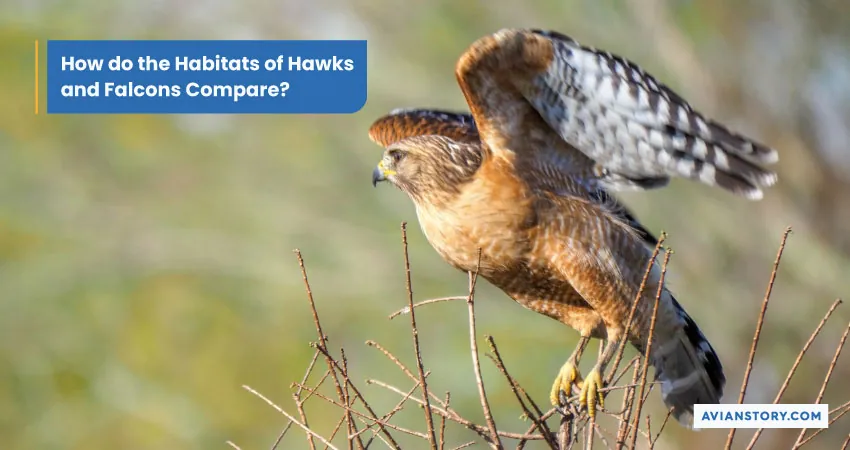
Here is an in-depth description of their habitats:
Typical habitats of Hawks
Here are some typical habitats of hawks that are commonly found:
- Forests and woodlands: Many hawk species are well adapted to forested areas. They can be found in deciduous and coniferous forests, where they take advantage of the abundant prey and suitable nesting sites. Hawks such as the Red-tailed Hawk and Cooper’s Hawk are frequently encountered in wooded habitats.
- Open fields and grasslands: Several hawk species prefer open habitats like fields and grasslands. These areas provide them with unobstructed views and opportunities to spot their prey from above. The Northern Harrier and Rough-legged Hawk are examples of hawks that frequent these habitats, often hunting small mammals and birds.
- Wetlands and marshes: Wetland habitats offer a diverse range of prey, including amphibians, reptiles, and small mammals. The Red-shouldered Hawk and the Osprey inhabit wetland areas, where they utilize perches near water to search for food.
- Coastal areas: Coastal regions provide hawks with a rich food source, such as fish and shorebirds. Species like the White-tailed Hawk and the Northern Harrier can be found along coastlines, utilizing these environments’ unique resources.
- Mountains and high elevations: Some hawk species are adapted to mountainous habitats, where they soar and hunt in rugged terrain. Mountain-dwelling hawks, such as the Red-tailed Hawk and the Rough-legged Hawk, use updrafts and thermals to navigate and search for prey.
- Urban and suburban areas: Certain hawk species have successfully adapted to human-altered environments, including urban and suburban areas. They exploit abundant food resources like pigeons, rodents, and small birds.
The Red-tailed Hawk and the Cooper’s Hawk are examples of hawks in urbanized landscapes.
Typical Habitats of Falcons
Here are some typical habitats where falcons are commonly found:
- Open grasslands and savannas: Falcons such as the Peregrine Falcon and the Saker Falcon are known to inhabit open grasslands and savannas. These habitats provide them with ample space for high-speed flights and hunting opportunities for their preferred prey.
- Coastal areas and cliffs: Species like the Peregrine Falcon are well adapted to coastal cliffs. Here, they build nests and use their incredible speed to dive and capture seabirds in flight. They can also be found near estuaries and coastal wetlands.
- Deserts and arid regions: Species like the Merlin and the Lanner Falcon are known to inhabit these habitats. Here, they hunt small birds, lizards, and insects.
- Mountains and cliffs: Falcons are often associated with mountainous habitats and rocky cliffs. Their powerful flight allows them to navigate the rugged terrain with ease.
The Gyrfalcon, for instance, is known to inhabit Arctic regions and mountainous areas, using cliffs as nesting sites and hunting grounds.
- Urban and suburban areas: Certain falcons have adapted to urban environments, taking advantage of tall buildings and structures for nesting and hunting. The Peregrine Falcon, in particular, has successfully adapted to urban landscapes. It utilizes skyscrapers as substitutes for cliffs and preying on pigeons and other urban-dwelling birds.
- Forested areas: While falcons are generally associated with open habitats, some species can also be found in forested areas. The Aplomado Falcon, for example, is known to inhabit open woodlands and savannas with scattered trees.
Comparative Analysis of Hawks Vs Falcons Habitat Preferences
Hawks are found in a wide range of environments, whether open or secluded. They live in dense forests to open grasslands, displaying their adaptability. The birds also thrive in both urban and rural landscapes.
In contrast, falcons prefer open habitats. Examples are grasslands, deserts, and coastal areas. They also love elevated nesting sites, such as cliffs or tall structures. This further highlights their preference for open and elevated environments.
How do Hawks and Falcons Adapt to Their Environments?
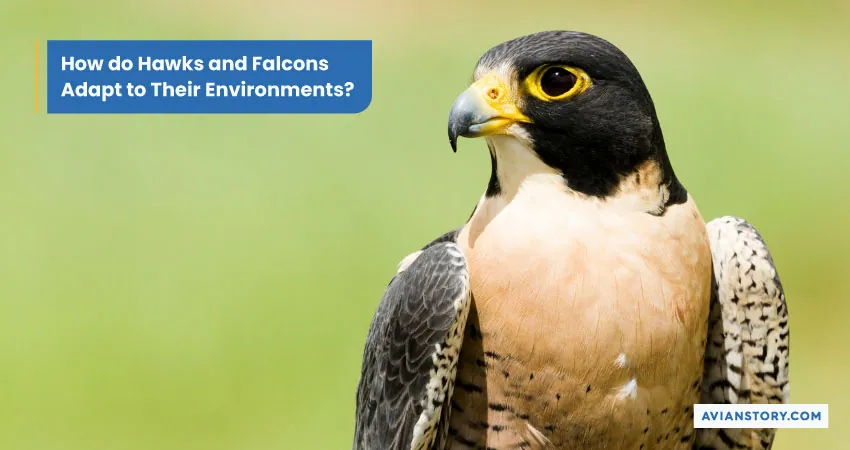
Hawks and falcons are highly adaptable birds of prey with specialized adaptations to thrive in their respective environments.
Adaptation Strategies of Hawks
Hawks use the following to adapt to their environments:
- Territorial behavior: Hawks are known for their territorial nature, defending their grounds and nesting areas from intruders. This behavior ensures a stable food supply and suitable breeding sites within their preferred habitat.
- Nesting habits: Hawks strategically choose nesting locations that offer protection and concealment. Nesting in trees or on cliffs allows them to avoid ground-based predators and provide a safe environment for their offspring.
Adaptation Strategies of Falcons
Falcons, on the other hand, have these adaptations:
- Beak and Talon: Falcons have a notched beak called a “tooth” that allows them to deliver precise, lethal bites to their prey. Their long, sharp talons enable them to catch and dispatch their target swiftly.
- Nesting preferences: Falcons nest in various locations, including cliff ledges, rocky crevices, or man-made structures such as tall buildings and bridges. These nesting sites provide safety and protection from ground-based predators.
- Eye structure: These raptors also possess a bony ridge called the “eyebrow projection” above their eyes. It helps protect their eyes from glare and wind during high-speed flights. The adaptation allows falcons to maintain clear vision even at incredible speeds.
How do Hawks and Falcons Hunt Their Prey?
Hawks and falcons, both predatory birds, employ different hunting techniques to capture their prey.
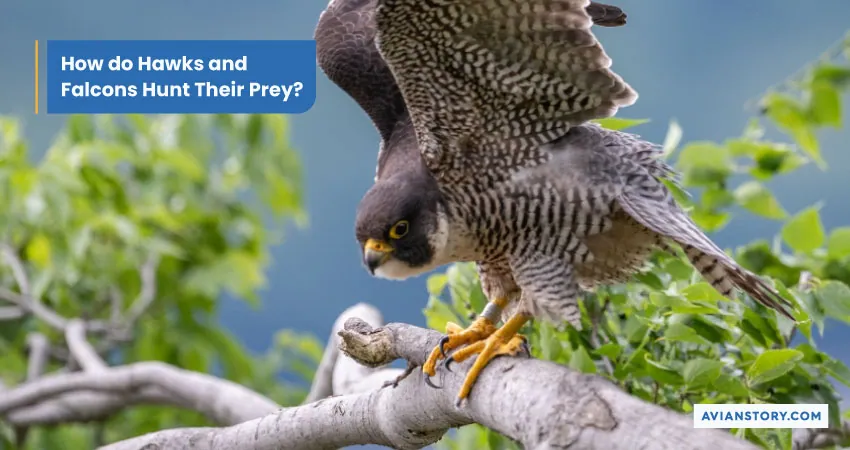
Hunting Techniques of Hawks
These raptors use the following techniques:
- Perching and ambushing: Many hawk species rely on perching from elevated positions, such as tree branches or utility poles. This allows them to scan their surroundings for potential prey.
- Stealth and surprise attacks: Hawks employ camouflage techniques and take advantage of their surroundings to remain inconspicuous. With stealth and surprise, hawks swoop on unsuspecting prey, often targeting small mammals, birds, reptiles, or insects.
- Cooperative hunting: Some hawk species, such as the Harris’s Hawk, exhibit cooperative hunting behavior. They hunt in groups, using coordinated tactics to increase their chances of success.
One hawk may flush out prey from hiding while others wait strategically to intercept and capture it.
Hunting Techniques of Falcons
Falcons will search for their prey with the following techniques:
- High-speed dives or “stooping”: Falcon’s primary hunting technique is the high-speed dive, known as “stooping.” Falcons climb to great heights, often using thermal updrafts, tuck their wings close to their bodies and plummet toward their prey with astonishing velocity.
- Aerial pursuit: Falcons excel at chasing down fast-moving prey in open spaces. Once they spot a potential target, they engage in an impressive aerial pursuit. Falcons utilize their exceptional speed and maneuverability to maneuver through the air, making quick adjustments to match the movements of their prey. They relentlessly pursue their quarry until they are within striking range.
- Precision strikes: Falcons possess exceptional vision and can track fast-moving objects in flight. They target a variety of prey, including other birds, bats, and small mammals, often snatching them directly from the air.
Comparison of Falcon vs Hawk Hunting Techniques
While hawks rely on patience, perching, and surprise attacks, falcons utilize speed, agility, and aerial pursuit to capture their prey.
Hawks’ hunting techniques are often suited for more close-range encounters and stalking. Whereas falcons’ hunting techniques are optimized for high-speed aerial pursuits and quick strikes.
How do Hawks and Falcons Compare in Terms of Speed and Agility?

In terms of speed, falcons are widely recognized as the fastest birds in the animal kingdom. Their streamlined bodies, long wings, and pointed wingtips allow them to achieve incredible flight velocities.
The Peregrine Falcon is the fastest recorded speed during a hunting stoop. These birds have a record of reaching astonishing speeds of over 242 miles per hour (390 kilometers per hour).
While hawks may not match the extraordinary speed of falcons, they possess impressive agility and maneuverability. Hawks have a more robust build and broader wings than falcons, enabling them to soar and glide efficiently.
The red-tailed hawk holds the record for the fasted hawk. It can cruise at an impressive speed of 118 miles per hour (190 kilometers per hour). This is nowhere near the fastest Falcon.
Mating and Reproduction Processes of Hawks and Falcons
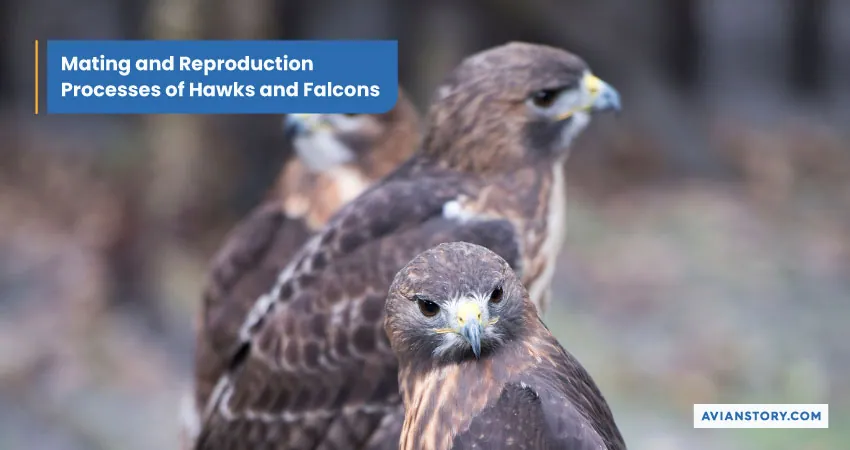
Mating and reproduction processes vary among different hawk and falcon species. But they generally involve courtship rituals, egg-laying, incubation, and raising of offspring.
Mating Rituals and Reproduction Process of Hawks
Hawks have the following reproduction characteristics:
- Mating season: Mating occurs from January to late June for most species. Southern hawks mate early, while northern hemisphere hawks mate late in the year.
- Courtship displays: Hawks engage in elaborate courtship displays to attract mates. These displays can include aerial acrobatics, sky dances, vocalizations, and gift offerings of prey or nesting materials.
- Egg-laying: Female hawk lays a clutch of eggs. The number of eggs laid can vary depending on the species, ranging from one to five per year. The female usually lays one egg every two to three days.
- Incubation: The female hawk primarily incubates the eggs, while the male provides food during this period. Incubation durations range from 21 to 35 days, depending on the species.
- Raising the Young: After the eggs hatch, both parents feed and raise the chicks. They regurgitate food for the young, gradually introducing them to solid prey items as they grow.
Mating Rituals and Reproduction Process of Falcons
Falcons’ mating and reproduction characteristics include the following:
- Mating season: Falcons mate from late March up to April or May. Like hawks, the exact time depends on their location, with those in the southern hemisphere mating earlier.
- Courtship displays: Falcons engage in displays involving aerial acrobatics, calling, and territorial behavior. They often perform breathtaking aerial displays, showcasing their flying skills to impress potential partners.
- Egg-laying: Once a nest is prepared, the female falcon lays a clutch of eggs. The number of eggs can vary among species, typically from one to four. The female lays one egg every few days until the clutch is complete.
- Incubation: The female falcon is primarily responsible for incubating the eggs, while the male provides food during this period. The incubation lasts 29 to 32 days.
- Fledging and juvenile stage: After hatching, the young falcons, called eyasses, grow rapidly under the care of both parents. They are fed regurgitated food the adults bring until they are ready to fledge or leave the nest.
How Do the Lifespans of Hawks and Falcons Compare?
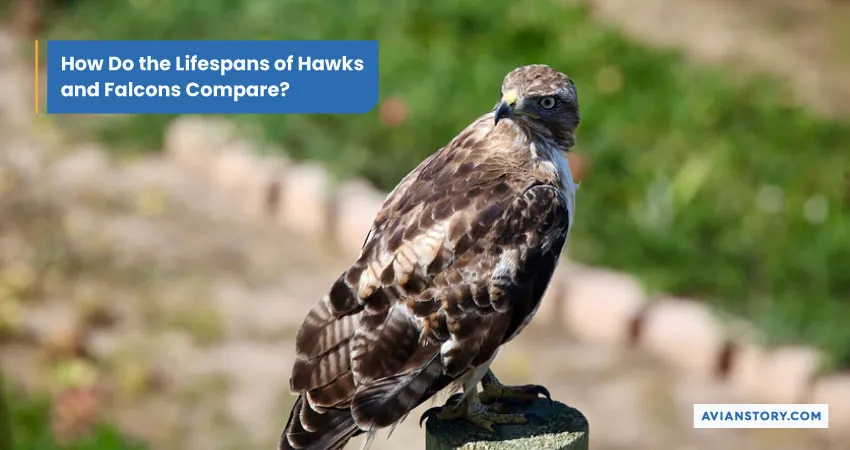
Hawks, on average, tend to have longer lifespans compared to falcons. Many hawk species can live for 10 to 20 years in the wild. Some individuals reach even older ages of up to 30 years in captivity.
Falcons, on the other hand, typically have relatively shorter lifespans compared to hawks. While there is variation among falcon species, their average lifespan in the wild ranges from 5 to 20 years.
Falcons will live longer in captivity, where they are protected from natural predators and have access to proper care and nutrition.
What is the Impact of Hawks and Falcons on the Ecosystem?
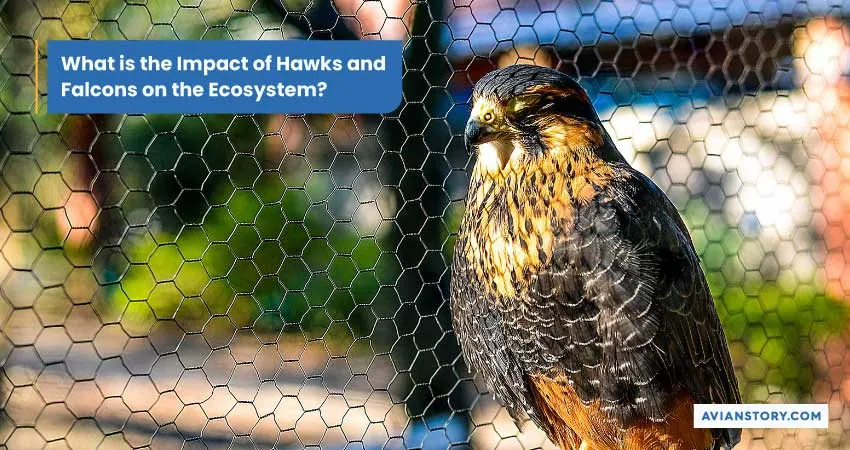
Hawks and falcons play crucial roles in maintaining the balance and health of the ecosystems they inhabit. Their presence and activities have significant impacts on the ecosystem in the following ways:
- Regulation of prey populations: Hawks and falcons are top predators in their respective food chains. Hunting and preying on a variety of small mammals, birds, reptiles, and insects help control the populations of these prey species.
- Pest control: Many hawks and falcons have a diet that includes rodents and other small mammals. They are natural predators of agricultural pests such as mice, voles, and rabbits.
- Scavenger contributions: While hawks and falcons are primarily hunters, they also contribute indirectly as scavengers. They may consume carrion, including roadkill or other carcasses. That reduces potential disease transmission and cleans up decaying organic matter from the environment.
- Indicator species: Their presence, population dynamics, and breeding success can reflect the quality and availability of suitable habitats, prey availability, and the overall well-being of ecosystems.
Monitoring their populations and behaviors can provide valuable insights into ecosystem changes and the impacts of human activities.
How are Hawks and Falcons Used in Falconry and Sports Hunting?
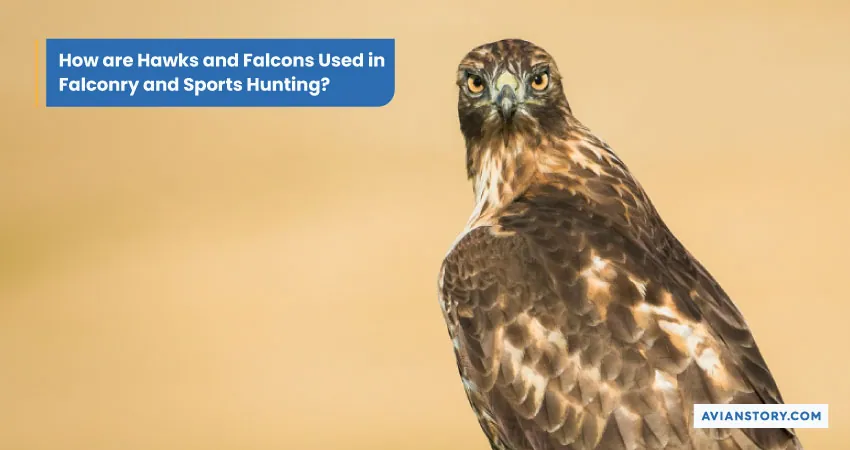
Hawks and falcons have a long history of being used in falconry, an ancient art and sport of hunting with trained birds of prey.
Hawks in Falconry
The following species are widespread in falconry:
- Harris’s hawk: The Harris’s hawk is a popular choice for falconry due to its social nature and cooperative hunting behavior. Multiple Harris’s hawks can be flown together, forming a “hawk team.” They work cooperatively to flush out prey and take turns capturing it.
- Red-tailed hawk: Red-tailed hawks are versatile birds often used in falconry. They are adaptable and can hunt various prey, including small mammals and birds. Their powerful talons and sharp beaks make them effective hunters in various environments.
- Goshawk: Goshawks are known for their speed, agility, and fierce hunting abilities. They are used in falconry for pursuing game birds such as pheasants and grouse. Goshawks are prized for their excellent flying skills and intense predatory instincts.
Falcons in Falconry
Falcons used in falconry include:
- Peregrine falcon: Peregrine falcons are renowned for their exceptional speed and aerial prowess. They are the fastest birds in the world and are highly prized in falconry. Peregrines are used to hunt game birds, such as pigeons and waterfowl.
- Saker falcon: Saker falcons are medium-sized falcons that are well-suited for falconry. They have a wide range and can hunt various prey, including game birds and small mammals. Saker falcons are valued for their endurance, agility, and adaptability to different terrains.
- Gyrfalcon: These species are large, mighty falcons that excel in hunting large game birds and waterfowl. They are known for their strength, high-altitude flights, and tenacity in pursuing their prey. Gyrfalcons are used in falconry for their ability to take down challenging preys.
Conclusion
честные казино с быстрыми выплатами
бездепозитные бонусы казино
играть в лучшем казино на деньги
база казино с бездепозитным бонусом
онлайн казино России
casino oyunu
Hawks and falcons are both remarkable raptors with distinct characteristics and adaptations. Hawks are known for their diverse hunting techniques, cooperative behavior, and adaptable habitats. Falcons, on the other hand, excel in speed, aerial pursuit, and precision strikes.
Understanding these hawks vs falcons differences is crucial for conservation efforts as it aids in protecting their habitats. It also helps conserve prey species and promote sustainable practices in falconry and sport hunting.
